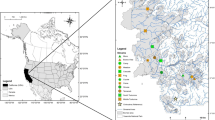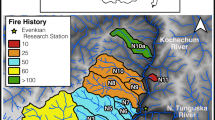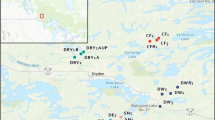Abstract
Terrestrial soils in forested landscapes represent some of the largest mercury (Hg) reserves globally. Wildfire can alter the storage and distribution of terrestrial-bound Hg via reemission to the atmosphere or mobilization in watersheds where it may become available for methylation and uptake into food webs. Using data associated with the 2007 Moonlight and Antelope Fires in California, we examined the long-term direct effects of wildfire burn severity on the distribution and magnitude of Hg concentrations in riparian food webs. Additionally, we quantified the cross-ecosystem transfer of Hg from aquatic invertebrate to riparian bird communities; and assessed the influence of biogeochemical, landscape variables, and ecological factors on Hg concentrations in aquatic and terrestrial food webs. Benthic macroinvertebrate methylmercury (MeHg) and riparian bird blood total mercury (THg) concentrations varied by 710- and 760-fold, respectively, and Hg concentrations were highest in predators. We found inconsistent relationships between Hg concentrations across and within taxa and guilds in response to stream chemical parameters and burn severity. Macroinvertebrate scraper MeHg concentrations were influenced by dissolved organic carbon (DOC); however, that relationship was moderated by burn severity (as burn severity increased the effect of DOC declined). Omnivorous bird Hg concentrations declined with increasing burn severity. Overall, taxa more linked to in situ energetic pathways may be more responsive to the biogeochemical processes that influence MeHg cycling. Remarkably, 8 years post-fire, we still observed evidence of burn severity influencing Hg concentrations within riparian food webs, illustrating its overarching role in altering the storage and redistribution of Hg and influencing biogeochemical processes.







Similar content being viewed by others
Data availability
The data are available at Herring et al. 2023.
References
Ackerman JT, Eagles-Smith CA, Herzog MP, Hartman CA, Peterson SH, Evers DC, Jackson AK, Elliot JE, Vander Pol SS, Bryan CE (2016) Avian mercury exposure and toxicological risk across western North America: a synthesis. Sci Total Environ 568:749–769
Allen EW, Prepas EE, Gabos S, Strachan WMJ, Zhang WP (2005) Methylmercury concentrations in macroinvertebrates and fish from burned and undisturbed lakes on the boreal plain. Can J Fish Aquat Sci 62:1963–1977
Bank MS, Loftin CS, Jung RE (2005) Mercury bioaccumulation in northern two-lined salamanders from streams in the northeastern United States. Ecotoxicology 14:181–191
Barbour MT, Gerritsen J, Snyder BD, Stribling JB (1999) Rapid bioassessment protocols for use in streams and wadeable rivers: periphyton, benthic macroinvertebrates and fish, 2nd edn. EPA 841-B-99-002. U.S. Environmental Protection Agency; Office of Water; Washington, D.C.
Barrow NJ, Cox VC (1992) The effects of pH and chloride concentration on mercury sorption II. by a soil. J Soil Sci 43:305–312
Biswas A, Blum JD, Klaue B, Keeler GJ (2007) Release of mercury from Rocky Mountain forest fires. Global Biogeochem Cycles 21(GB1002):1–13
Brown JA, Robertson BL, McDonald T (2015) Spatially balanced sampling: application to environmental survey. Procedia Environ Sci 27:6–9
Cal Fire (2023) Incidents | CAL FIRE. Accessed 14 Nov 2023
Chaves-Ulloa R, Taylor BW, Broadley HJ, Cottingham KL, Baer NA, Weathers KC, Ewing HA, Chen CY (2016) Dissolved organic carbon modulates mercury concentrations in insect subsidies from streams to terrestrial consumers. Ecol Appl 26:1771–1784
Chen CF, Ju YR, Lim YC, Chen CW, Wu CH, Lin YL, Dong CD (2020) Dry and wet seasonal variation of total mercury, inorganic mercury, and methylmercury formation in estuary and harbor sediments. J Environ Manage 253:109683
Cleckner LB, Gilmour CC, Hurley JP, Krabbenhoft DP (1999) Mercury methylation in periphyton of the Florida everglades. Limnol Oceanogr 44:1815–1825
Craig PJ, Moreton PA (1985) The role of speciation in mercury methylation in sediments and water. Environ Pollut Series B 10:141–158
Cristol DA, Brasso R, Condon AM, Fovargue RE, Friedman SL, Hallinger KK, Monroe AP, White AE (2008) The movement of aquatic mercury through terrestrial food webs. Science 320:335
Cristol DA, Evers DC (2020) The impact of mercury on North American songbirds: effects, trends, and predictive factors. Ecotoxicology 29:1107–1116
DeGraaf RM, Tilghman NG, Anderson SH (1985) Foraging guilds of North American birds. Environ Manag 9:493–536
Desrosier M, Planas D, Mucci A (2006) Mercury methylation in the eipilithon of Boreal Shield aquatic ecosystems. Environ Sci Technol 40:1540–1546
Driscoll CT, Mason RP, Chan HM, Jacob DJ, Pirrone N (2013) Mercury as a global pollutant: sources, pathways, and effects. Environ Sci Technol 47:4967–4983
Dutton J, Fisher NS (2012) Influence of humic acid on the uptake of aqueous metals by the killifish Fundulus heteroclitus. Environ Toxicol Chem 31:2225–2232
Eagles-Smith CA, Herring G, Johnson B, Graw R (2016) Conifer density within lake catchments predicts fish mercury concentrations in remote subalpine lakes. Environ Pollution 212:279–289
Eagles-Smith CA, Silbergeld EK, Basu N, Bustamante P, Diaz-Barriga F, Hopkins WA, Kidd KA, Nyland JF (2018) Modulators of mercury risk to wildlife and humans in the context of rapid global change. Ambio 47:170–197
Eidenshink J, Scwind B, Brewer K, Zhu Z, Quayle B, Howard S (2007) A project for monitoring trends in burn severity. Fire Ecology 3:3–21
Erdozain M, Kidd K, Kreutweiser D, Sibley P (2019) Increased reliance of stream macroinvertebrates on terrestrial food sources linked to forest management intensity. Ecol Appl 29:e01889
Friedli HR, Radke LF, Lu JY, Banic CM, Leatich WR, MacPherson JI (2003) Mercury emissions from burning of biomass from temperate North American forests: laboratory and airborne measurements. Atmos Environ 37:253–267
Grigal DF (2003) Mercury sequestration in forests and peatlands: a review. J Environ Quality 32:393–405
Herring G, Eagles-Smith CA, Tennant LB, Willacker JJ, Johnson M, Siegel RB, Polasik JS (2023) Mercury in bird blood and benthic aquatic invertebrates in Plumas National Forest, 2015–2016: U.S. Geological Survey data release, https://doi.org/10.5066/P9OZ0R9M
Hsu-Kim H, Eckley CS, Achá D, Feng X, Gilmour CC, Jonnson S, Mitchell CPJ (2018) Challenges and opportunities for managing aquatic mercury pollution in altered landscapes. Ambio 47:141–169
Jackson AK, Eagles-Smith CA, Robinson WD (2021) Differential reliance on aquatic prey subsidies influences mercury exposure in riparian arachnids and songbirds. Ecol Evol 11:7003–7017
Jardine TD, Kidd KA, Rasmussen JB (2012) Aquatic and terrestrial organic matter in the diet of stream consumers: implications for mercury bioaccumulation. Ecol Appl 22:843–855
Kelly EN, Schindler DW, St Louis VL, Donald DB, Vladicka KE (2006) Forest fire increases mercury accumulation by fishes via food web restructuring and increased mercury inputs. Proc Natl Acad Sci USA 103:19380–19385
Kim CS, Rytuba JJ, Brown Jr GE (2003) EXAFS study of mercury(II) sorption to Fe- and Al-(hydr)oxides. II. Effects of chloride and sulfate. J Colloids Inter Sci 270:9–20
Knutsen CJ, Varian-Ramos CW (2020) Explaining variation in Colorado songbird blood mercury using migratory behavior, foraging guild, and diet. Ecotoxicology 29:1268–1280
Lambertsson L, Nilsson M (2006) Organic material: the primary control on mercury methylation and ambient methylmercury concentrations in estuarine sediments. Environ Sci Tech 40:1822–1829
Mailman M, Bodaly RA (2005) Total mercury, methylmercury, and carbon in fresh and burned plants and soil in Northwestern Ontario. Environ Pollut 138:161–166
Mauro J, Guimarães J, Hintelmann H, Watras C, Haack E, Coelho-Souza S (2004) Mercury methylation in macrophytes, periphyton, and water—comparative studies with stable and radio-mercury additions. Anal Bioanal Chem 374:983–989
Mehrotra AS, Sedlak DL (2005) Decrease in net mercury methylation rates following iron amendment to anoxicwetland sediment slurries. Environ Sci Tech 39:2564–2570
Merrit RW, Cummins KW, Berg MB (2008) An introduction to the aquatic insects of North America, 4th edition. Kendall Hunt
Mitchell CPJ, Gilmour CC (2008) Methylmercury production in a Chesapeake Bay salt marsh. J Geophys Res Biogeosci 113:G00C04
NWCG [National Wildfire Coordinating Group] (2005) Glossary of wildland fire terminology. National interagency fire center. Boise, Idaho http://www.nwcg.gov/pms/pubs/pubs. Htm#PMS205. Accessed 20 May 2021
Obrist D, Johnson DW, Edmonds RL (2012) Effects of vegetation type on mercury concentrations and pools in two adjacent coniferous and deciduous forests. J Plant Nutr Soil Sci 175:68
Obrist D, Kirk JL, Zhang L, Sunderland EM, Jiskra M, Selin NE (2018) A review of global environmental mercury processes in response to human and natural perturbations: changes of emissions, climate, and land use. Ambio 47:116–140
Patel KF, Jakubowski MD, Fernandez IJ et al. (2019) Soil nitrogen and mercury dynamics seven decades after a fire disturbance: a case study at Acadia National Park. Water Air Soil Pollut 230:29
Pyle P (1997) Identification guide to north American birds Part 1: Columbidae to Ploceidae. 2nd edn. Slate Creek Press, Point Reyes Station, CA, USA
Rimmer CC, McFarland KP, Evers DC, Miller EK, Aubry Y, Busby D, Taylor RJ (2005) Mercury levels in Bicknell’s thrush and other insectivorous passerine birds in montane forests of the northeastern United States and Canada. Ecotoxicology 14:223–240
Riva-Murray K, Chasar LC, Bradley PM, Burns DA, Brigham ME, Smith MJ, Abrahamsen TA (2011) Spatial patterns of mercury in macroinvertebrates and fishes from streams of two contrasting forested landscapes in the eastern United States. Ecotoxicology 20:1530–1542
R Core Team (2021) R: A language and environment for statistical computing. R Foundation for Statistical Computing. https://www.R-project.org/
Rogers BM, Balch JK, Goetz SJ, Lehmann CER, Turetsky M (2020) Focus on changing fire regimes: interactions with climate, ecosystems, and society. Environ Res Letter 15:030201
Shanely J, Kamman N, Clair TA, Chalmers AT (2005) Physical controls on total and methylmercury in streams and lakes of Northeastern USA. Ecotoxicology 14:125–134
Snodgrass J, Jagoe CH, Bryan Jr AL, Brant HA, Burger J (2000) Effects of trophic status and wetland morphology, hydroperiod, and water chemistry on mercury concentrations in fish. Can J Fish Aquat Sci 57:171–180
Solt F, Hu Y, Kenkel B (2022) Package ‘interplot’. Interplot: Plot the Effects of Variables in Interaction Terms (fhcrc.org)
Townsend JM, Driscoll CT, Rimmer CC, McFarland KP (2014) Avian, salamander, and forest floor mercury concentrations increase with elevation in a terrestrial ecosystem. Environ Toxicol Chem 33:208–215
Tremblay A, Lucotte M, Rheault I (1996) Methylmercury in a benthic food web of two hydroelectric reservoirs and a natural lake of northern Quebec (Canada). Water Air Soil Pollut 91:255–269
U.S. Environmental Protection Agency (2000) Mercury in solids and solutions by thermal decomposition, amalgamation, and atomic absorption spectrophotometry. Method 7473. Test methods for evaluating solid waste, physical/chemical methods SW 846, Update IVA; US Government Printing Office: Washington, DC
U.S. Environmental Protection Agency (2001) Methyl mercury in water by distillation, aqueous ethylation, purge and trap, and cold-vapor atomic fluorescence spectrometry. Office of Water and Office of Science and Technology, Washington, DC. Method 1630. EPA-821-R-01-020
Wagner K, Bengtsson MM, Findlay RH, Battin TL, Ulseth AJ (2017) High light intensity mediates a shift from allochthonous to autochthonous carbon use in phototrophic stream biofilms. J Geophys Res: Biogeo 122:1806–1820
Ward DM, Nislow KH, Folt CL (2010) Bioaccumulation syndrome: identifying factors that make some stream food webs prone to elevated mercury bioaccumulation. Annal New York Acad Sci 1195:62–83
Webster JP, Kane TJ, Obrist D, Ryan JN, Aiken GR (2016) Estimating mercury emissions resulting from wildlife in forests of the Western United States. Sci Total Environ 568:578–586
Wei X, Hayes DJ, Fernandez I (2021) Fire reduces riverine DOC concentration draining a watershed and alters post-fire DOC recovery patterns. Environ Res 16:024022
Wiener JG, Knights BC, Sandheinrich MB, Jeremiason JD, Brigham ME, Engstrom DR, Woodruff LG, Cannon WF, Balogh SJ (2006) Mercury in Soils, Lakes, and Fish in Voyageurs National Park (Minnesota): Importance of Atmospheric Deposition and Ecosystem Factors. Environ Sci Technol 40:6261–6268
Willacker JW, Eagles-Smith CA, Kowalski BM, Denehy RJ, Jackson AK, Adams EM, Evers DC, Eckley CS, Tate MT, Krabbenhoft DP (2019) Timber harvest alters mercury bioaccumulation and food web structure in headwater streams. Environ Pollut 253:636–645
Windham-Myers L, Marvin-Dipasquale M, Krabbenhoft DP, Agee JL, Cox MH, Heredia-Middleton P, Kakouros E (2009) Experimental removal of wetland emergent vegetation leads to decreased methylmercury production in surface sediment. J Geophys 114:G2
Zoffoli HJ, Varella CA, do Amaral-Sobrinho NM, Zonta E, Tolon-Becerra A (2013) Method of median semi-variance for the analysis of left-censored data: comparison with other techniques using environmental data. Chemosphere 93:1701–1709
Acknowledgements
This research was funded by the USDA Forest Service and U.S. Geological Survey (Contaminant Biology Program and Ecosystems Mission Area). We thank W. Catellino, C. Dillingham, K. Doten, C. Emery, S. Hardy, D. Hodges, B. Johnson, C. Kruse, J. Lee, K. Nowlin, J. Pierce, C. Rumrill, R. Taylor, and C. Wisotzky, for field and lab assistance, and S. Peterson and two anonymous reviewers provide constructive feedback on earlier drafts. The use of trade, product, or firm names in the publication is for descriptive purposes only and does not imply endorsement by the U. S. Government. This product paper has been peer-reviewed and approved for publication consistent with USGS Fundamental Science Practices (http://pubs.usgs.gov/circ/1367/).
Author contributions
Conceptualization: MJ, CAE; Methodology: LBT, JJW, MJ., C.A.E.; Formal analysis and investigation: GH, LBT, RBS, JSP; Writing – original draft preparation: GH; Writing – GH, LBT, JJW, MJ, RBS, JSP, CAE; Funding acquisition: MJ, CAE.
Author information
Authors and Affiliations
Corresponding author
Ethics declarations
Conflict of interest
The authors declare that they have no conflict of interest.
Additional information
Publisher’s note Springer Nature remains neutral with regard to jurisdictional claims in published maps and institutional affiliations.
Rights and permissions
About this article
Cite this article
Herring, G., Tennant, L.B., Willacker, J.J. et al. Wildfire burn severity and stream chemistry influence aquatic invertebrate and riparian avian mercury exposure in forested ecosystems. Ecotoxicology 33, 131–141 (2024). https://doi.org/10.1007/s10646-024-02730-6
Accepted:
Published:
Issue Date:
DOI: https://doi.org/10.1007/s10646-024-02730-6




